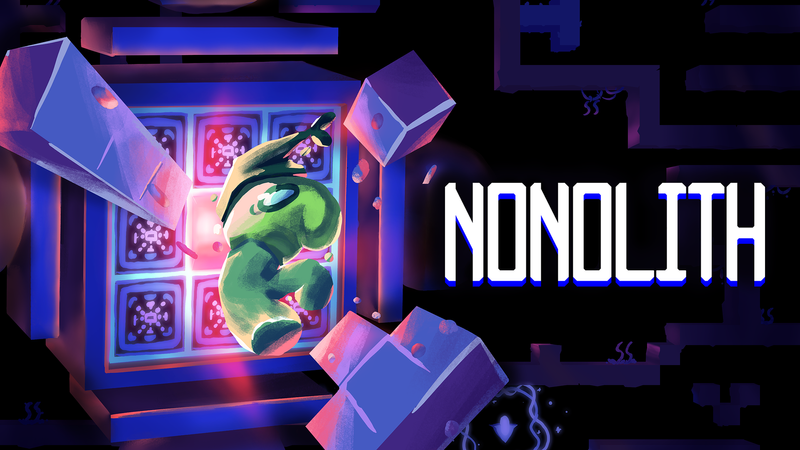Schim is one of those games that clicks right away. Maybe it’s how your void black frog hero jumps between shadows with a satisfying plop! Maybe it’s the charming bite-sized levels that'll put a silly grin on your face within a minute. Or maybe it’s because I’ve never played a puzzly platformer quite like this before. Whatever it is, Schim’s straightforward but playful movement is immediately easy to understand, and once you’ve gotten the knack of its shadow-hopping mini-misadventures, the game will practically follow your waking thoughts like a, well, shadow.
But first things first, what is a schim? The game’s blurb calls them “the soul and spirit of an object, thing, or living being. Everything in the world has one. A schim should never be separated from their thing!” Woah. Deep. As for what this “schim” actually does, it’s best to remember them as the oddly cute, ink-black frog blob that we play as throughout the game.
Our schim has lost its “thing” - which in this case is a human. During the game's opening act, we watch the human grow from a child to an adult in a sappy montage before disaster strikes. The human accidentally becomes untethered from the little guy and our frog friend then goes on an adventure to reunite with its human.
Every one of the 65 levels (that can last anytime between ten seconds and ten minutes) has us hopping from shadow to shadow in gorgeous two-tone environments that take us from idyllic suburban streets and supermarkets to moody underground subways. Levels also forgo detail in exchange for vibrant colours. A lovely park level is basked in a salmon pink hue at sunset, while nighttime levels are blanketed in deep and moody blues. It's all starkly contrasted with the bodies of matte black shadows blotched across the screen.
Schim’s minimalistic palette is gorgeous, but it’s also clearly readable as you need to navigate the darkness with certainty. Our schim can leap out of a shadow once, and if the little lad fails to land in another shadow, he’ll get an extra, smaller hop to skip back to safety. Otherwise, our frog friendo dissolves in the sun. The game's thinkyness comes from safely and confidently getting from one shadow to the next without going poof.
Schim is a puzzle platformer, which might come as a surprise as platformers usually don’t stick to an isometric angle for annoying-camera-related issues. But Schim is almost definitely a platformer all the same because it’s all about the only two things platformers need to be all about: the jump and the platform.
Schim constantly evolves and remixes the relationship between the two. Early levels will mostly have you jumping from one static object’s shadow to another, before graduating to things in motion - gasp - a mum pushing a buggy across the sidewalk, a large van, a flying bird’s faraway shadow, a family of geese waddling by. These small obstacles are the Super Mario equivalent of blocks sliding left to right and back again.
Correctly timing your jumps becomes increasingly vital, and complicated, as time goes on. When you jump into the shadows of certain objects, you can 'possess' them and activate a small ability (think Ghost Trick: Phantom Detective). One level tasks you with jumping into the shadow of traffic lights to manipulate the traffic so you can safely cross a busy intersection. A night level introduces lightning, forcing you to move quickly since certain shadows will blink out of existence in the next half-second. Schim is at its best when being playful with its environment and toying with cool lighting gimmicks because, aside from being fun surprises, you immediately recognize the physics wizardry at play. I might not be able to scientifically explain how/why shadows balloon and shrink and contort when confronted with headlights turning a corner - but I do understand it on a more intuitive, natural level, and maybe that’s why Schim just clicks straight away.
My first hop through Schim was a relaxed 4-5 hours, but that all changes once the credits roll and you have the option to disable the second, ‘saving grace’ jump. There’s also an extra ‘Risky Mode’ that gives you 20 lives (one-ups) in total before you’re rewound to the very beginning of the game.
While Schim starts as the perfect game to enjoy a brew with, these last two toggles properly squeeze the thinky juices out. Base game Schim is playful. I experimented. I asked questions like, ‘Can I jump through that fence? What if I snuck into that woman’s shadow for her entire walk? How do other schim’s feel about being stuck with cutlery or weapons of mass destruction?’
Schim with one or both of these toggles turned on is an altogether different beast that makes you consciously spot patterns in the urban landscapes, taking note of the route every object, animal, and human takes so you can jump aboard at the most opportune moment.
Some shorter levels definitely feel like filler moments (what with their short and simple A to B routes that don’t introduce new ideas), but even in these throwaway, largely forgettable stages, Schim’s charming personality always shines through. Big schims leer out of bouncy castles and trucks. Our schim ends rainy nighttime levels hiding under makeshift shelters, bundled up with other glowy, bobbly eyes. You'll meet fellow lost schims who are also separated from their thing, leaving it up to you to find a stray, shadowless object - be it a basketball, egg or road sign - to reunite them. This secret shadow-creature community gives the game’s walkable, European-esque cityscapes a magical undertone like there’s some shadowy alternate society filled with fuzzy creatures watching us move through life.
And that might be Schim’s greatest strength: inviting you into an alternate way of being. Schim runs on the same daydreaming logic you’d idly think up when bored on the tube, and everything from the world’s borders, our character’s movement, and the magical goings-on sweeps you away to that reality.







